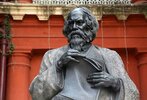No worries. Important is you take pain to read it. Thank you.Yeah. My bad. I didn't see who wrote that message
You are using an out of date browser. It may not display this or other websites correctly.
You should upgrade or use an alternative browser.
You should upgrade or use an alternative browser.
Simple Sa questions...???
- Thread starter Nihaaa
- Start date
ShootChalo chalo times up..
It's time to another question..
Yeah we coolNo worries. Important is you take pain to read it. Thank you.
But he designs letters for his gf only!Not me.. I swear
(or Pinglay) Venkayya
The design of the flag of India that was first presented in 1921 to Mahatma Gandhi, leader of the All-India Congress, was created by Pingali (or Pinglay) Venkayya.
Pingali Venkayya was born on 2 August 1876 or 1878 at Bhatlapenumarru, near Machilipatnam,
in what is now the Indian state of Andhra Pradesh.
His parents were
Hanumantha Rayudu and
Venkata Ratnam...
He studied at the Hindu High School in Machilipatnam,
but also spent his childhood in various places in the Krishna district like Yarlagadda and Pedakallepalli.
He married Rukminamma, the daughter of the Karanam of Pamarru village..
At the age of 19,
Venkayya had enrolled in the British Indian Army and was deployed to South Africa during the Second Boer War (1899–1902).
During the war when the soldiers had to salute the Union Jack,
the national flag of Britain, Venkayya realised the need for having a flag for Indians.
When Venkayya attended the AICC session in 1906 in Calcutta, he was inspired to design a flag for the Indian National Congress as he opposed the idea of hoisting the British flag at Congress meetings.
Various flags had been used by members of the Indian independence movement before independence was achieved in 1947.
Pingali Venkayya designed the National Flag and presented it to Mahatma Gandhi during the latter's visit to Vijayawada on 1 April 1921.
Venkayya's first draft of the flag was in red and green — the red
representing Hindus and green the Muslims living in the country.
On Gandhi's suggestion, Venkayya added a white stripe to represent all other denominations and religions present in India.
Since 1921, Venkayya's flag has been used informally at all Congress meetings.
The flag was adopted in its present form during a meeting of the Constituent Assembly on
22 July 1947.
Venkayya was an agriculturist, as well as an educationist who set up an educational institution in Machilipatnam.
He died in relative poverty in 1963 and was largely forgotten by society.
A postage stamp was issued to commemorate him in 2009. In 2012, his name was proposed for a posthumous Bharat Ratna though there has been no response from the central government on the proposal...
...
....
...
Rabindra nath Tagore ji
| Born | Rabindranath Tagore7 May 1861 Calcutta, Bengal Presidency, British India (present-day Kolkata, West Bengal, India) |
He was a poet, musician, and artist who was a polymath. In 1913, he was awarded the Nobel Prize for Literature for his poem Geetanjali. Gora, Raja and Rani, Binodini, and Nauka Dubi are some of his well-known novels. Rabindra Sangeeth, a piece of popular Bengali music, was influenced by him.

- Gurudev is the name given to Rabindranath Tagore.
- In Kolkata, he founded Shanti Niketan (Vishwa Bharti University) in 1921.
- Jana Gana Mana’ and Bangladesh’s ‘Amar Shonar Bangla’ are two of his most famous works.
- He was a poet, musician, and artist who was a polymath.
- In 1913, he was awarded the Nobel Prize for Literature for his poem Geetanjali.
- Gora, Raja and Rani, Binodini, and Nauka Dubi are some of his well-known novels.
- His work has been translated into many languages and is used as part of school and college curriculum.
- Rabindra Sangeeth, a piece of popular Bengali music, was influenced by him.
- Kabuliwala is one of Rabindranath’s many short stories.
- At the age of 80, he died in Kolkata in 1941.
Peacock
In 1963,
the peacock was declared the National Bird of India because of its rich religious and legendary involvement in Indian traditions.
The criteria for this choice were many. The bird must be well-distributed within the country so it could truly 'national'.
The Indian peacock,
Pavo cristatus,
the National Bird of India, is a colourful, swan-sized bird, with a fan-shaped crest of feathers, a white patch under the eye and a long, slender neck.
No idea about this10) When is world Environment Day celebrated ??
Answer: A) Transportation of oxygen in the bloodQuestion 11. What is the function of the human respiratory system?
A) Transportation of oxygen in the blood
B) Digestion of food
C) Pumping blood to the body
D) Excretion of waste product
Explanation: The respiratory system is responsible for the exchange of gases (oxygen and carbon dioxide) between the body and the environment.

